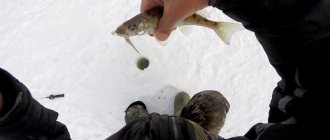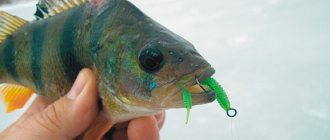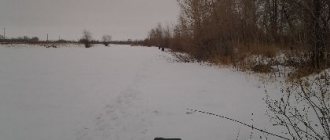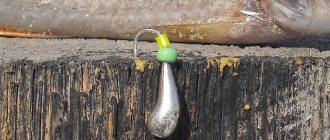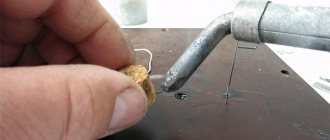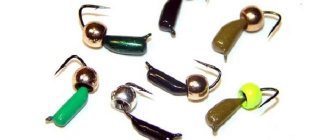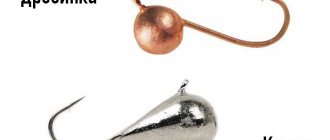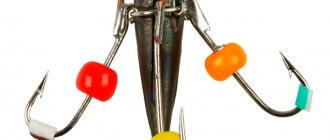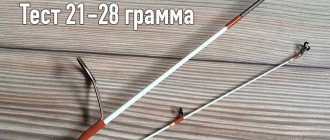Design
The Uralochka jig has the shape of an elongated and slightly curved drop. A single hook is soldered into the narrow end of the jig. There are two modifications of the uralochka: with a through hole in the body of the jig and with a loop soldered into the end of the jig.
These or other additional elements are usually put on the shank of the uralochka hook: beads, beads, cambrics.
Puncture of the Uralochka jig for passing fishing line
The hole for winding the fishing line in a home-made lead jig can be pierced with a thin awl or a needle held in pliers.
Punctured channel holes for passing fishing line in Uralochka jig blanks of various shapes are shown in Figure 1 with blue lines “d”. The main thing here is not to make a mistake in choosing the place where the fishing line enters the body of the jig, since for any jig this point will be the reference point.
Incorrect location of the starting point for puncturing the channel for passing the fishing line will lead to the skew of the finished jig in the water space or will not correspond to the angle of inclination selected for it in space.
At this point, making the body of the Uralochka jig with your own hands can be considered complete. All that remains is to solder a suitable hook into the finished lead jig blank.
Options
Size
The size of the uralochka is a few millimeters or a small centimeter and depends on the material from which it is made. If tungsten is used, then the required weight is achieved even when making a small jig due to the large specific gravity of this metal. Lead jigs are usually larger, just like tin jigs, which have the lowest specific gravity.
Weight
The weight of the jig is determined mainly by the depth at which it is used. At a depth of up to two meters, they fish with jigs weighing 0.5 g. With an increase in depth to 5 meters, the mass of the jig increases to 1 gram. At great depths, jigs weighing from 1 to 1.5 grams are used. In addition, the size and weight of the jig depend on the object being fished. In particular, bream prefers large jigs, even if fishing occurs at shallow depths.
Material
The greater the specific gravity of the jig, the smaller its size for the same mass. Tungsten is used for fishing in currents or when you have to catch cautious fish with small baits. Lead urals are used most often. If the jig is made of tin, then it has a small specific gravity and, accordingly, a different game, which is sometimes necessary. In addition, Ural jigs are made of bronze and copper.
Color
The jig got its name because it looks similar to an amphipod or jig , since its play in the water resembles the movements of this invertebrate. Natural jigs are colored green, brown, and sometimes red. But the small fish can have any color, depending on the taste preferences of the fish in the pond and the imagination of the fisherman. Still, the most commonly used color is black, less often brown, purple and dark green. In addition, natural silver and golden colors are popular.
Expert opinion
Knipovich Nikolai Mikhailovich
Zoologist, hydrobiologist. I am interested in fishing at a professional level.
Healthy! In bright sun and clear water, jigs of natural colors are considered the most catchy. In cloudy weather and at great depths, baits of provocative colors: red or yellow can be attractive.
Additional items
beads (one or two pieces), a bead or one or two multi-colored cambrics must be put on the shank of the hook . The color of the additional element should contrast with the color of the jig itself. Thus, black jigs are usually equipped with yellow or white decorations. When fishing with natural bait, additional elements do not need to be used, although most likely they will be useful.
Types of Uralka bait
Products may differ from each other in shape and color. It’s good if a fisherman has several varieties, for example, tungsten jig PIRS Uralka. When the fish swallows the hook, the line is rolled back.
Form
When choosing bait, you need to take into account the depth of the reservoir. The further the bottom is, the heavier the jig should be. A heavy model is easier to control than a light one. If a fisherman is going to fish in a shallow body of water, the depth of which does not exceed 2 m, it is enough to use a jig weighing up to 0.5 g. If the depth is average (up to 5 m), it is better to choose a heavier bait. Its weight should be at least 1 g. Deep reservoirs (8 m or more) require careful selection of jigs; for fishing, you should use bait weighing from 1 to 1.5 g.
The weight of the product depends on the material of manufacture. In order for the fish to attack the bait, you need to buy jigs of a sufficiently large size. Small products should be used only for catching small fish. You can buy models that look like a cube or a drop.
The larger the jig, the more important its shape is. Small products look like crustaceans. Due to the fact that there are a lot of them in reservoirs, the fish may ignore such bait. To make fishing enjoyable and to increase the bite, you can buy different baits.
Color spectrum
The catch depends on the appearance of the jig. The brighter it is, the better it is visible to the fish. When choosing models, it is necessary to take into account the conditions in which the fishing will take place. If the weather is cloudy, the water in the lake or river is dark, you need to choose light-colored products. On a sunny day, it is better to use baits of dark shades; the same rule applies to reservoirs with clean water. The Uralka F4 black nickel jig is in demand among fishermen.
Universal jigs include black and silver jigs; dark green and copper products are in demand. Tungsten jigs or models made of brass have proven themselves well. In stores, fishermen will purchase dark purple, brown and dark green jigs.
What kind of fish do they catch?
Using the Uralochka jig you can catch perch and almost any non-predatory fish, namely:
- Bream. Bream prefers large black or red jigs. You can fish both with bait and without bait. With any fishing method, the game should not be too fractional, and if bloodworm larvae are used, then the movements should be smooth and leisurely.
- Roach. Roach prefers small jigs and faster play.
- Ruff. The “king” of reservoirs prefers animal bait on a hook.
- Guster. Fishing resembles bream fishing.
- Crucian carp. Crucian carp prefers leisurely play with a jig.
- Yazya. Ide often lives together with bream, so there is no need to specially select a game when fishing for it.
Perch can be caught with or without bait; often baitless fishing is more effective.
How to choose the right jig?
In order to choose the right jig model, you need to know the characteristics of the reservoir and the preferences of the fish that will be hunted. All this will help you choose the size, weight, color and shape that will be most suitable.
Size and weight
The weight of the bait greatly depends on the depth where the fishing is supposed to take place. The greater the depth, the greater the weight should be. All this is explained by the fact that at depth it is much easier to control a heavy jig than a light jig: the thread will straighten worse and play more slowly.
There are several tips that will help determine the weight of the jig:
- When fishing at shallow depths, up to 2 meters, the weight should not exceed 0.5 g;
- When fishing at medium depths of up to 5 meters, the weight of the bait increases to 1 g;
- If the depth increases to 8 meters, then the most optimal weight is from 1 g to 1.5 g.
- Choosing the most suitable size is very important. Usually the weight of the bait depends on the material from which it is made
- manufactured.
For example, large lead models work well for catching large fish such as:
- Bream
- Perch
- Ruff
- Roach
Small jigs are very similar to crustaceans, which in most cases are already in abundance, so the fish may not be tempted by them. Small baits are good for catching small fish, or species with a small mouth.
It is best to take models that are large enough and can play actively, forcing the fish to attack. The larger the bait, the more important its shape is to obtain a catch.
Color
The larger the size of the jig, the more important its color, because the fish will be able to better see the offered treat.
Universal colors are:
- Silver
- Black
- Copper
- Dark green
- Brass
- Brown
- Dark purple
In general, the color depends on the fishing conditions. The darker the water in the pond, the lighter the color should be, especially if the weather is cloudy. And if fishing is to be done in light water and on a sunny day, then you can use jigs of dark colors.
Material
The most common materials from which jigs are made are:
- Tungsten. Their volume is much smaller than that of models made from other materials, with the same weight. This helps you descend to the desired depth much faster. Such baits are often used when hunting at great depths with strong currents, because they can play quite an active and interesting game in such conditions. You can catch bream, ide, ram, perch, roach, and crucian carp with tungsten jigs.
- Lead. This material allows you to quickly reach depth even with a small size. Lead baits are ideal for catching cautious and capricious fish. With their help you can catch perch, silver bream, bream and roach.
- Tin. Such models are very lightweight and are capable of playing smoothly even with small sizes. They are convenient for fishing in reservoirs with weak currents or no current at all. They mainly catch roach and crucian carp.
Comparison of the Uralochka with other jigs
In terms of popularity, Uralochka occupies the top places in the ranking of jigs, but it has serious competitors. The comparative properties of various jigs are shown in Table 1.
Table 1 - Comparison of various jigs
| Name of jig | Number of hooks | Without nozzle | With nozzle |
| Uralochka | 1 | Used | Used |
| Pellet | 1 | Not used | Used |
| Ant | 1 | Not used | Used |
| Goat | 2 | Used | Not used |
| Devil | 3 | Used | Rarely used |
| Witch | 3 loose | Used | Not used |
| Sharaga | 4 | Used | Not used |
An analysis of Table 1 allows us to conclude that the Uralochka jig is the most universal , since fish bite on it both when fishing with a nozzle and without using it.
The Uralochka can be used when fishing in still waters and in currents, while some jigs are ineffective when fishing in rivers. But as baitless jigs, the “goat”, “devil” and “witch” can be more catchy, especially when fishing for perch. Due to the larger number of hooks with additional elements and more intense vibrations that occur in the water environment, these jigs seem more voluminous and can attract fish from a greater distance.
How to choose in a store
What to look for when choosing a Uralka jig in a fishing store?
- Workmanship. There should be no paint drips on the body of the jig. If there is a ring, it should not be painted over.
- Quality of hooks. The hooks should be sharp and of the required thickness: when fishing with bloodworms, they should have a smaller thickness.
- The edges of the hole for passing the fishing line must be flared, otherwise loss of the bait is inevitable. This is essential for tungsten jigs.
- The hole should pass through the body of the jig at the desired angle.
Efficiency different times of the year
In summer, jig fishing is not very common, although at this time the use of a jig can be even more effective than in winter . In summer, the fish rushes to everything that seems attractive to it, while in winter it is more picky.
In the summer, you can fish with a Uralka jig from a boat on an onboard fishing rod, or use a long telescopic rod without a reel with a side nod. The jig is lowered vertically into “windows” in the grass thickets and played with. This kind of fishing is very effective when catching rudd.
In winter, fish are more capricious and the fisherman often has to face a dilemma: whether to fish with an animal bait or use a no-bait option. Both can be effective, but success is largely determined by the behavior of the fishing target, and this, in turn, depends on many factors.
Step-by-step instructions on how to tie to a fishing line
Depending on whether the jig has a ring for tying a fishing line, or whether a through hole is intended for this purpose, a different sequence of actions is performed.
Tying a fishing line to a ring
The fishing line is threaded through the ring and tied with a clinch knot or some other fishing knot.
How to knit through a hole in the body
In order to tie a jig to a fishing line, proceed as follows:
- Thread the line through the hole in the body.
- Form a loop parallel to the shank of the hook.
- Make several (4-5) turns of the fishing line around the shank of the hook and the loop pressed against it.
- Pass the free end of the fishing line into the loop, preferably twice, and tighten the knot, after wetting it.
DIY making
Only a few can make a tungsten ural with their own hands, but a lead jig is quite simple to make. To make it you will need:
Tools:
- Knife;
- flat slab;
- soldering iron;
- an awl or sharp needle;
- file or needle file;
- grinding materials.
Materials:
- Lead rod;
- wire for the ring;
- soldering acid;
- hook;
- primer;
- dye.
The manufacturing process of a Uralka jig includes the following steps:
- The lead rod is rolled out on a slab, giving one end the shape of a truncated cone.
- Cut a piece of the cone to the desired length.
- By resting against any hard surface, the workpiece is given the desired bend.
- Use an awl or needle to make a hole.
- Solder in a hook and, if necessary, a ring for attaching the fishing line.
- Process the workpiece.
- The jig is primed and painted.
- Add additional items.
Expert opinion
Knipovich Nikolai Mikhailovich
Zoologist, hydrobiologist. I am interested in fishing at a professional level.
Attention! The most important operation in making a fishing rod is to pierce a hole, since the position of the jig in the water will depend on this. The sharper the angle relative to the longitudinal axis of the jig, the more horizontal position it will occupy in the water.
In order to make the manufacturing process more convenient, you can first solder the hook and make a hole, and only then cut the workpiece from the rod.
If the jig tied to the fishing line is not in the correct position that the angler would like, you can solder a little lead onto the end of the bait (crown), or, conversely, grind off the excess with a file. If the jig has a soldered loop, then you can, within certain limits, adjust the angle of the jig by carefully bending the loop in one direction or another.
Making a jig “Lesotka” with your own hands
Having learned the nuances of making the Lesotka jig, you can solve two problems at once. The first is to learn to distinguish the high-quality “Lesotki” sold in retail outlets (and they exist) from the models passed off as them, which are sometimes frankly useless (these are exhibited even at major exhibitions). The second is to master how to make it yourself at home. Fortunately, it’s easy to purchase all the materials and tools needed for this today. There are more than enough offers for the sale of tungsten wire, varnishes are no problem at all, plus the most basic tool that probably everyone has in the house.
Alexander himself uses tungsten wire with a diameter of 0.5 mm, but thinner wire of 0.3 mm can be wound. But starting from a diameter of 0.6 mm, the wire becomes quite brittle when bending and therefore is not suitable for winding on a hook with a shank with a diameter of 0.3 - 0.5 mm (and this is what “Lesotka” jigs are mainly made for).
Hooks are used Nos. 18 – 14. They should have a small reserve of ductility. An example of a successful model is Gamakatsu F21 (photo No. 16. They are additionally captivating because of their sharp edge, which provides high notchability and does not require finishing with a needle file.
Photo 8
Before winding, the metal of the hook must be released a little, heated red-hot and cooled in air. However, not the entire hook heats up - the area near the eye heats up, which will then need to be restored to a vertical position. And the beginning of the bend (the back of the head) is also heated, in order to increase the winding area by straightening it (the finished product is then bent again). However, you should not bring the entire forend red hot, because winding hard wire on soft metal is inconvenient.
Datsenko came up with an original way to heat the hook in such local areas, leaving others cold. He clamps it in pliers, and then successively heats the exposed areas in the flame of a match or lighter. The thin wire of the hook heats up to the desired temperature quickly - in 7 - 10 seconds, and the closed areas are protected by the massive cold metal of the tool. You should not burn the wire longer, otherwise it will become covered with scale and become too brittle. Alexander measures the required dose of heat, ingeniously using a match for heat treatment (photo 9). While one half of it is burning, the ear is ignited, and the bend is processed with the other half.
Photo 9
A few seconds after calcination, the metal cools down. The eyelet and the top of the bend are easily aligned with pliers. But before you start winding, it’s worth remembering that there will only be one attempt, because tungsten wire is very brittle.
For ease of twisting of the wire, it is initially advisable to bend its tip, 1.5 - 3 mm long, at a right or slightly smaller angle (photo 10). Then clamp it with pliers (photo 11), or in a vice. Winding is done with the thumb and forefinger.
Photo 10
Photo 11
One finger holds the forend so that it does not deform itself, the second bends the wire, and the force is applied no further than a centimeter from the hook (photo 12). This is done in 3-4 tight turns. After this, you can stop winding and move the resulting spring as far as possible towards the bend (photo 13) in order to fully use the length of the forend.
Photo 12
Photo 13
Then the workpiece is again fixed in the pliers - and winding resumes. Having wound it to the eye, you should start winding it in the opposite direction. The second layer does not have to be twisted to the end, but finished after four to five turns (photo 14), carefully biting off the ends of the wire (after filing these ends with a diamond file - photo 15).
Photo 14
Photo 15a
Photo 15b
The result is a jig, which is nicknamed “Lesotka” (photo 16). With such a heavy bait you can fish effectively even at depths of over three meters and in the current. When winding in one row, the jig is more often used at shallow depths.
Photo 16a
Photo 16b
To give the resulting bait a more attractive appearance to fish, the shank of the hook along with the body can be slightly bent (photo 17).
Photo 17
Tactics and fishing techniques
Tactics and techniques for catching urinal fish differ when fishing with and without bait. Tactically, baitless fishing is closer to winter trolling - the fisherman should move more around the reservoir in search of fish, without staying in one place for a long time. The technique of fishing with a baitless jig involves high-frequency play with a jig. The most fractional game attracts perch; “peaceful” fish should be caught by playing with a jig at a moderate pace.
Fishing with an animal bait involves a longer wait for a bite . As a rule, bait is used. Even perch can be fed with bloodworms, let alone “white” fish. The fisherman should know the peculiarities of feeding when fishing in currents and in still water. Fishing on rivers means that jigs need to be heavier. Playing with a jig with a nozzle is slower and smoother. Bloodworm larvae, maggots, pieces of worms and burdock moth larvae are used as bait.
In any case, when fishing with a jig, carry out the following actions:
- Lower the jig to the bottom and hit the bottom with it several times, creating a cloud of turbidity;
- make a lift, playing with a nod of the fishing rod;
- at the top point make a short pause;
- gradually lower the jig down;
- repeat the cycle several times.
Expert opinion
Knipovich Nikolai Mikhailovich
Zoologist, hydrobiologist. I am interested in fishing at a professional level.
Important! You should never fish only the bottom horizon. Any fish, except, perhaps, the ruffe, can live in the middle layers of water, and not looking for it there would be a crime.
Content:
- 1 Myths about nozzle jigs
- 2 Effects of nozzle jigs
- 3 Where do you get baitless jigs of unusual shapes?
- 4 Making nozzle-free jigs with your own hands
- 5 Jigs with additional attachments
- 6 Techniques for fishing with jigs
- 7 Catching roach with a baitless jig
- 8 Conclusion
You can buy jigs in the fishing department of the store or make them yourself, especially since it is not at all difficult.
